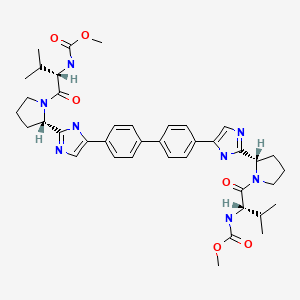CASRN: 1009119-64-5

Drug Levels and Effects
Summary of Use during Lactation
Daclatasvir has been removed from the US market. It has not been studied in nursing mothers being treated for hepatitis C infection. Because it is 99% bound to maternal plasma proteins, amounts in breastmilk are likely to be very low. If daclatasvir used alone or in combination with sofosbuvir is required by the mother, it is not a reason to discontinue breastfeeding.[1] Some sources recommend against breastfeeding when daclatasvir is used with ribavirin.
Hepatitis C is not transmitted through breastmilk and breastmilk has been shown to inactivate hepatitis C virus (HCV).[2-5] However, the Centers for Disease Control recommends that mothers with HCV infection should consider abstaining from breastfeeding if their nipples are cracked or bleeding. It is not clear if this warning would apply to mothers who are being treated for hepatitis C.
Infants born to mothers with HCV infection should be tested for HCV infection; because maternal antibody is present for the first 18 months of life and before the infant mounts an immunologic response, nucleic acid testing is recommended.[2,5]
Drug Levels
Maternal Levels. Relevant published information was not found as of the revision date.
Infant Levels. Relevant published information was not found as of the revision date.
Effects in Breastfed Infants
Relevant published information was not found as of the revision date.
Effects on Lactation and Breastmilk
Relevant published information was not found as of the revision date.
Alternate Drugs to Consider
(Hepatitis C) Interferon Alfa, Interferon Alfacon-1, Peginterferon Alfa
References
- 1.
- Spera AM, Eldin TK, Tosone G, Orlando R. Antiviral therapy for hepatitis C: Has anything changed for pregnant/lactating women? World J Hepatol 2016;8:557-65. [PMC free article: PMC4840161] [PubMed: 27134703]
- 2.
- Cottrell EB, Chou R, Wasson N, et al. Reducing risk for mother-to-infant transmission of hepatitis C virus: A systematic review for the U.S. Preventive Services Task Force. Ann Intern Med 2013;158:109-13. [PubMed: 23437438]
- 3.
- Pfaender S, Heyden J, Friesland M, et al. Inactivation of hepatitis C virus infectivity by human breast milk. J Infect Dis 2013;208:1943-52. [PubMed: 24068703]
- 4.
- Tovo PA, Calitri C, Scolfaro C, et al. Vertically acquired hepatitis C virus infection: Correlates of transmission and disease progression. World J Gastroenterol 2016;22:1382-92. [PMC free article: PMC4721973] [PubMed: 26819507]
- 5.
- Workowski KA, Bachmann LH, Chan PA, et al. Sexually transmitted infections treatment guidelines, 2021. MMWR Recomm Rep 2021;70:1-187. [PMC free article: PMC8344968] [PubMed: 34292926]
Substance Identification
Substance Name
Daclatasvir
CAS Registry Number
1009119-64-5
Drug Class
Breast Feeding
Lactation
Milk, Human
Antiviral Agents
NS5A Inhibitors
Disclaimer: Information presented in this database is not meant as a substitute for professional judgment. You should consult your healthcare provider for breastfeeding advice related to your particular situation. The U.S. government does not warrant or assume any liability or responsibility for the accuracy or completeness of the information on this Site.
Publication Details
Publication History
Last Revision: September 15, 2023.
Copyright
Attribution Statement: LactMed is a registered trademark of the U.S. Department of Health and Human Services.
Publisher
National Institute of Child Health and Human Development, Bethesda (MD)
NLM Citation
Drugs and Lactation Database (LactMed®) [Internet]. Bethesda (MD): National Institute of Child Health and Human Development; 2006-. Daclatasvir. [Updated 2023 Sep 15].